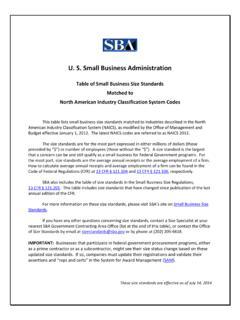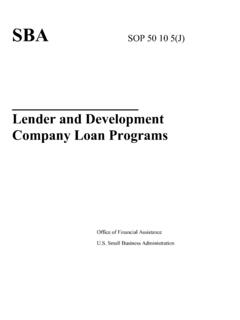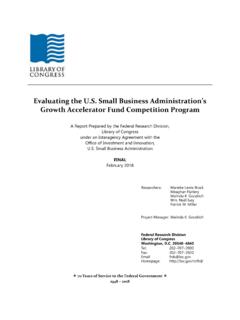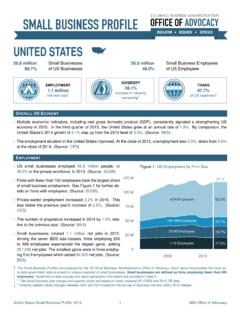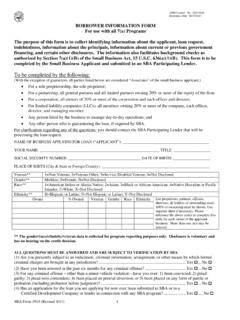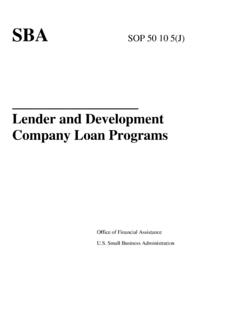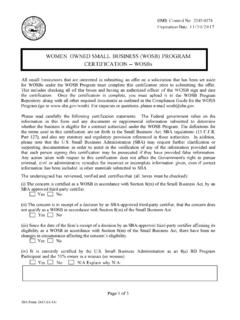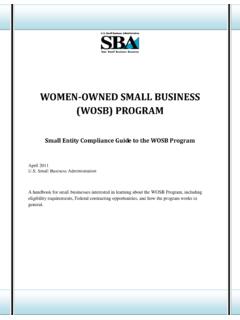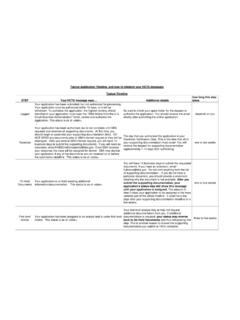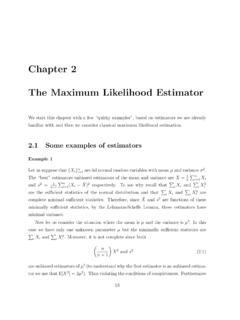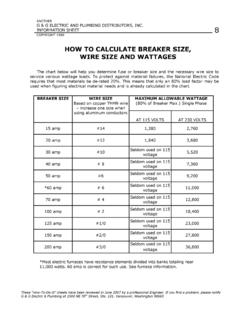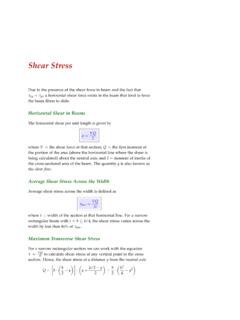Transcription of Second Draw Paycheck Protection Program (PPP) Loans: How ...
1 As of January 19, 2021 Second Draw Paycheck Protection Program (PPP) Loans: How to calculate Revenue Reduction and maximum Loan Amounts Including What Documentation to Provide The small business administration (SBA), in consultation with the Department of the Treasury, is providing this guidance to assist businesses in calculating their revenue reduction and payroll costs (and the relevant documentation that is required to support each set of calculations) for purposes of determining their eligibility for and amount of a Second Draw PPP Loan. Borrowers and lenders may rely on the guidance provided in this document as SBA s interpretation of the CARES Act, the Economic Aid Act, and the Paycheck Protection Program Interim Final Rules.
2 The government will not challenge lender PPP actions that conform to this guidance1 and to the PPP Interim Final Rules and any subsequent rulemaking in effect at the time the action is taken. Revenue Reduction 1. Question: What are gross receipts for the purpose of determining eligibility for a Second Draw PPP Loan? Answer: For a for-profit business , gross receipts generally are all revenue in whatever form received or accrued (in accordance with the entity s accounting method, , accrual or cash) from whatever source, including from the sales of products or services, interest, dividends, rents, royalties, fees, or commissions, reduced by returns and allowances but excluding net capital gains and losses. These terms carry the definitions used and reported on IRS tax return forms.
3 Gross receipts do not include the following: taxes collected for and remitted to a taxing authority if included in gross or total income, such as sales or other taxes collected from customers (this does not include taxes levied on the concern or its employees); proceeds from transactions between a concern and its domestic or foreign affiliates; and amounts collected for another by a travel agent, real estate agent, advertising agent, conference management service provider, freight forwarder or customs broker. All other items, such as subcontractor costs, reimbursements for purchases a contractor makes at a customer s request, investment income, and employee-based costs such as payroll taxes, may not be excluded from gross receipts.
4 For a nonprofit 501(c)(3) organization, a 501(c)(19) veterans organization, an eligible nonprofit news organization, an eligible 501(c)(6) organization, or an eligible destination marketing organization, gross receipts means gross receipts within the 1 This document does not carry the force and effect of law independent of the statutes and regulations on which it is based. As of January 19, 2021 meaning of section 6033 of the Internal Revenue Code of 1986, which is the gross amount received by the organization during its annual accounting period from all sources without reduction for any costs or expenses including, for example, cost of goods or assets sold, cost of operations, or expenses of earning, raising, or collecting such amounts.
5 Thus gross receipts includes, but is not limited to: (i)the gross amount received as contributions, gifts, grants, and similar amounts without reduction for the expenses of raising and collecting such amounts, (ii)the gross amount received as dues or assessments from members or affiliated organizations without reduction for expenses attributable to the receipt of such amounts, (iii)gross sales or receipts from business activities (including business activities unrelated to the purpose for which the organization qualifies for exemption, the net income or loss from which may be required to be reported on Form 990-T), (iv)the gross amount received from the sale of assets without reduction for cost or other basis and expenses of sale, and (v)
6 The gross amount received as investment income, such as interest, dividends, rents, and royalties. Gross receipts of a borrower s affiliates (unless a waiver of affiliation applies2) are calculated by adding the gross receipts of the business concern with the gross receipts of each For more information on what constitutes gross receipts by entity type, see FAQ 5 below. 2. Question: For all entity types ( , for-profit businesses and nonprofit organizations), do gross receipts include PPP Loan proceeds that are forgiven (or EIDL advances)? Answer: No. The amount of any forgiven First Draw PPP Loan or any EIDL advance, which are not subject to federal income tax, is not included in the calculation of gross receipts . 3. Question: What reference periods can be used to determine whether the A pplicant can demonstrate at least a 25 percent gross receipts reduction in order to qualify for a Second Draw PPP loan?
7 Answer: The appropriate reference periods depend on how long the Applicant has been in business : 2 See subsection (d) of the interim final rule titled business Loan Program Temporary Changes; Paycheck Protection Program Second Draw Loans posted on SBA s website January 6, 2021 (86 FR 3712). 3 If a borrower has acquired an affiliate or been acquired as an affiliate during 2020, gross receipts includes the receipts of the acquired or acquiring concern. This aggregation applies for the entire period of measurement, not just the period after the affiliation arose. However, if a concern acquired a segregable division of another business concern during 2020, gross receipts do not include the receipts of the acquired division prior to the acquisition.
8 Similarly, the gross receipts of a former affiliate are not included. This exclusion of gross receipts of such former affiliate applies during the entire period of measurement, rather than only for the period after which affiliation ceased. However, if a borrower sold a segregable division during 2020, the gross receipts will continue to include the receipts of the division that was sold. All terms in this paragraph have the meaning attributed to them by the IRS. As of January 19, 2021 For all Applicants, except those satisfying the conditions set forth below, the Applicant must demonstrate that gross receipts in any calendar quarter of 2020 were at least 25 percent lower than the same quarter of 2019.
9 Alternatively, Applicants may compare annual gross receipts in 2020 with annual gross receipts in 2019 if they were in business in 2019. For entities not in business during the first and Second quarters of 2019 but in operation during the third and fourth quarters of 2019, Applicants must demonstrate that gross receipts in any quarter of 2020 were at least 25 percent lower than during either the third or fourth quarters of 2019. For entities not in business during the first, Second , and third quarters of 2019 but in operation during the fourth quarter of 2019, Applicants must demonstrate that gross receipts in any quarter of 2020 were at least 25 percent lower than the fourth quarter of 2019. For entities not in business during 2019 but in operation on February 15, 2020, Applicants must demonstrate that gross receipts in the Second , third, or fourth quarter of 2020 were at least 25 percent lower than the first quarter of 2020.
10 4. Question: What documentation do I need to provide to corroborate that my entity sustained at least a 25 percent reduction in gross receipts? Answer: The following are the primary sets of documentation Applicants can provide to substantiate their certification of a 25 percent gross receipts reduction (only one set is required): Quarterly financial statements for the entity. If the financial statements are not audited, the Applicant must sign and date the first page of the financial statement and initial all other pages, attesting to their accuracy. If the financial statements do not specifically identify the line item(s) that constitute gross receipts, the Applicant must annotate which line item(s) constitute gross receipts.
